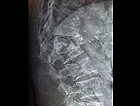Postmenopausal women with weak bones who took the osteoporosis remedies teriparatide and denosumab in combination, rather than sequentially, had increased bone-mineral density (BMD) after 12 months. The combination has the potential to lower fracture risk, according to an industry-sponsored trial.
Joy N. Tsai, MD,
from the Department of Medicine, Endocrine Unit, Massachusetts General Hospital, in Boston, and colleagues report their findings in an article published online May 15 in the Lancet.
According to the National Institutes of Health, some 40 million American women already have osteoporosis or are at high risk of developing the bone disease. The low bone mass and structural deterioration of bone increases the risk of fractures, especially at the hip, spine, and wrist.
Other investigators have tried to increase the value of osteoporosis remedies by testing amino bisphosphonates in combination with teriparatide or parathyroid hormone, but the results have been disappointing.
In the current study, Dr. Tsai and coauthors tested the combination of teriparatide and denosumab, a monoclonal antibody that inhibits osteoclast-mediated bone resorption. They screened 526 women aged 45 years or older who were at high fracture risk, and enrolled 100 into the open-label trial from September 2009 to January 2011. The women received 20 μg teriparatide per day or 60 mg denosumab every 6 months, or both for 12 months. They also took supplemental calcium and vitamin D.
Impressive Results
"In this 12-month randomised, controlled trial we show that combined teriparatide and denosumab increased BMD at the [posterior-anterior lumbar spine], femoral neck, and hip significantly more than either drug alone," the authors write. "Moreover, the 12-month changes in femoral-neck and total-hip BMD in the combination-therapy group (4.2% and 4.9%, respectively) were greater than have been reported with approved therapies for postmenopausal osteoporosis"
In an interview with
Medscape Medical News, Ethel Siris, MD, from Columbia University Medical Center, New York-Presbyterian Hospital, New York City, and director of the clinical osteoporosis program, calls the results "impressive."
Today, women at high risk for fracture are given teriparatide to improve the quality and quantity of bone. Then, to preserve those gains, women then get a drug similar to denosumab. "If you don't, whatever you gain will dwindle away," Dr. Siris said.
Building and preserving bone in the hip and the spine by using the therapies in combination is especially significant because fractures there are "devastating," she said. Hip fractures increase mortality and cause spikes in nursing home admissions; spine fractures "make people miserable" and deform the back.
However, Dr. Siris cautions that even though the study was well-executed, it remains just a single study. If the results are confirmed through larger trials and more is learned about the mechanism of action, "that is going to be a wonderful asset to the field," she told
Medscape Medical News.
The authors acknowledge that more work needs to be done before the combination is ready for clinical use but are enthusiastic about the findings. "Although studies are needed to assess reductions in fracture risk and to explore the effects of different doses and durations of treatment, the results of this trial suggest that this specific combination of drugs could be a useful option in the treatment of patients with osteoporosis at especially high risk of fracture," they conclude.
The researchers
presented an earlier version of the results at the American Society for Bone and Mineral Research (ASBMR) 2012 Annual Meeting.
Financial support for the study was provided by the Harvard Clinical and Translational Science Center; the National Center for Research Resources; Eli Lilly, which manufactures teriparatide; and Amgen, which manufactures denosumab. One study author is a consultant for Eli Lilly, and one coauthor was previously a consultant for Amgen. All authors disclosed receiving or having received research funding from Amgen and Eli Lilly. Dr. Siris is a consultant to Amgen and Eli Lilly.
Lancet. Published online May 15, 2013.
Abstract
http://www.medscape.com/viewarticle/804245






